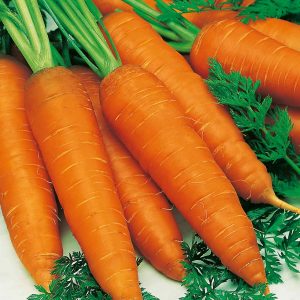Carrots are one of the main stays of the vegetable repertoire and have a fantastic colour – orange. They are highly versatile being used largely in salads, steamed and boiled or just gently roasted which makes them even sweeter.
Nutritionally, carrots are the single major source of beta-carotene which is a provitamin for A activity as well as having antioxidant activity.
Varieties To Choose From
There are far too many varieties to choose from. If you are after sweetness then we recommend two varieties:- Sugarsnax and Honeysnax. If carrot fly damage is a real nuisance then try Resistafly, FlyAway and Sytan. Other varieties grown and recommended are ‘Parmex’, a stumpy variety suited for eating whole, ‘Ideal’ which produces finger-sized, tender roots and the real favourite ‘Chantenay’. Finally, some of us like to produce carrot juice, so try the variety Cidera.
A number of heritage varieties are available and provide the grower with the widest range of colours and shapes available at any time.
Most varieties take 7 weeks from sowing to harvest which makes it a very quick growing harvest.
Sow between November and July.
Harvest from February through to October.
Sowing Carrot Seed
Dig or till the soil for a carrot bed when the soil is relatively dry to avoid creating lumps. Remove as many stones as possible. It is easiest to mix seeds with a small amount of sharp sand and sow the seeds and sand together. The best crops come from sowing where they are to grow.
Try to sow seeds in succession and from November through to July and preferably every three weeks seems reasonable. Sow seed 1.8cm (¾”) deep in drills 23-30cm (9-12″) apart. Thin seedlings when the first rough leaves appear, repeating as necessary until plants are 5-7.5cm (2-3″) apart. Row 6m (20′) or more. The early sowings will benefit from cloche protection.
Sow seeds thinly and any that sprout but are unwanted should be removed to avoid attracting Carrot Root Fly. Avoid crushing the leaves as the scent attracts the pest. As they grow, push soil over any exposed surfaces to reduce the green shoulder. Always ensure the water is well watered to avoid bolting.
Carrot seeds hate drying out and germinate slowly (14 to 21 days) so if you’re sowing seed in summer, a good way to keep them moist is to lay wet newspaper on top of the damp soil. Once the seedlings are showing their first rough leaves, thin out to 10cm apart which minimises competition and enables the carrots to grow quickly to harvest size.
Once carrots have grown, lift by late Autumn, remove soil and store in dry sand.
Sowing Guide In Pots: Reducing The Impact Of Carrot Fly
The easiest way to grow the finger varieties is to sow them in pots of compost. Why? To reduce the chance of the gardener’s nemesis, Carrot Fly. The carrot fly larvae feed on the roots, burrowing into them, causing the flesh to rot. Any barrier over 1 ½ feet can halt the flight of the female fly but they are still persistent in sowing their eggs near the root. It also makes them easy to harvest.

The usual method is to fill a large pot or a container with compost to within an inch of the rim. Pinches of seeds are then sowed thinly over the surface of the compost and then covered lightly.
The seedlings emerge and may have to be thinned to leave about 4cm (1 ½in.) between them. The compost must always be kept watered as drying leads to bolting.
The roots are best lifted young as they are at their tenderest. They can be crunched up straight from the pot or roasted with a touch of honey and mixed with herbs.
Dealing With Carrot Fly
Carrot fly often reveals its presence when you lift the carrots to find them spoilt by rust brown marks and tunnelled into by maggots. The fly also lays eggs near parsnips, celery and parsley but carrots seem to be most susceptible.
These maggots (larvae) are yellow-creamy being about 9 mm (1/3in.) in length. The fly can have up to three generations a year although two is more common.
Action:
Best to sow carrot seed after late spring and using the method already described. The first generation of larvae hopefully miss the sprouting although the carrots are harvested before late summer so that they miss the second generation.
Another way to protect carrots from the fly if more open areas are chosen is to cover with well-anchored fleece or the fleece-like pop-up covers, so the egg-laying females cannot lay their eggs close enough. Drenching with nematodes as well as erecting barriers are also possible. The best cultivation method is probably growing in pots.
Varieties To Grow:
cv. ‘Amsterdam Forcing 3’ – a fast maturing variety with deep orange, almost red tints. Harvested best when finger size because they have such sweet tasting roots with almost no core.
cv. Autumn King 2. A well regarded late developing maincrop. Smooth tapering roots are produced with good storage qualities. Sow March-August, harvest June-October. Buy this variety from Suttons Seeds (UK).

cv. Early Nantes. (1867). It originated in the market gardens of the Nantes district of Paris. A famous second early and maincrop type because it has a tapered, almost blunt and stumpy end. Hardly any core with excellent flavour, colour and texture. Sow from March to August for harvesting from July to October. Great for the early crop !
cv. Nairobi (AGM) A high-yielding variety that grows quickly, producing cylindrical roots with little core. Said to be very tender. Available from Sea Spring Seeds T: 01308 897 898 www.seaspringseeds.co.uk
cv. Norwich. A superb F1 Hybrid of the second early Nantes type which is harvested from July to September. Produces bulky, smooth, very good deep orange cylindrical roots, with good flavour and texture. This carrot grows to 17-20cm length and takes about 105 days from sowing to harvest.
cv. Chantenay Red Core 2. (1920) Has a very sweet flavour and ideal as a baby carrot. It produces evenly shaped, tapered roots with smooth skin and excellent colour. Sow in April to August and harvest from July to October, or when about 8 – 10cm long. Try the seeds from Simply Garden (UK)
cv. Resistafly. A cylindrical root with a nice orange colour and skin quality. A hybrid Nantes variant that has claims to be almost resistant to Carrot Root Fly. It apparently doesn’t attract the flies to lay eggs near it and the maggots don’t feed well on the roots.
cv. Carrot Solar Yellow. A maincrop variety with medium length roots and is completely yellow. Said to have a certain sweetness with a crunchy texture after cooking.
[Please note we are an affiliate marketing partner and will make a sales commission if you purchase any items through our affiliate links. Please read our affiliate disclosure]
Purchase your carrot seed here
Leave a Reply